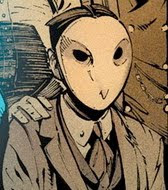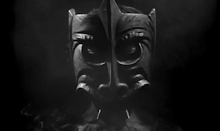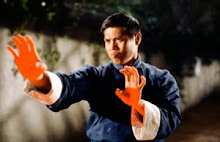
Kurosawa is often accused of being the most Western of the Japanese directors. At first sight this conventional wisdom seems correct, after all Kurosawa is often credited for rehumanizing the Japanese to the west post World War II. Kurosawa himself often re-enforced the view, causing a minor scandal when he named only a scant handful of Japanese films when asked to choose the best films of the last hundred years. However, the judgment of his style is based more on sins of omission then commission, best highlighted when compared to his contemparies. Goodwin underlines this when he states “Director’s Ozu and Mizoguchi are offered by Burch and other proponents of this argument as models of an ideal cultural autonomy.” Unlike Mizoguchi who consciously evoked Japanese scroll art in his compositions Kurosawa’s camera was free, gravitating more towards movement and montage then the more mise en scene oriented style of traditional Japanese cinema. Unlike Ozu whose stories and characters reflected and often hinged on the archetypically repressed emotions and desires that have come to define the Japanese mindset for many cineastes, Kurosawa’s character’s where all incredibly proactive, whether their desires where in the service of the state or themselves. In other words, if traditional Japanese cinema was about repression in both style and emotion, Kurosawa’s films where about expression.
On the other end of the spectrum Kurosawa’s films show a very Western reserve, when compared to the wild flagrant very Japanese style of the Japan’s post modern filmmakers. No matter how free his characters, or stylistic his compositions no one is ever going to confuse his films with the anarchic madness of Seijun Sezuki, Takeshi Kitano, Takeshi Miike or Kinji Fukusaku. In that sense it’s often difficult to define Kurosawa’s work in the context of Japanese film, his oeurve is neither fish nor fowl, as exemplifies neither the cinema of implication and reserve of the traditional Japanese cinema, nor the wild absurdist abandon of the future. It’s easier in the situation to label the work as Western, rather then have to define it using the strict rigors of its native country.
I believe that while Kurosawa’s style does have a distinctly Western flavor it is a mistake to assume, as many do that this means that he has an American flavor. Kurosawa’s popularity in America, and it’s influence on it’s filmmakers often causes this misconception, as did the mutual admiration between Kurosawa and John Ford (On a side note I’ve always thought the comparison spoke more to an Eastern influence in Ford. The signature shot of Ford that of small impermanent characters set before an immortal frame dominating landscape is also the signature image of Japanese Scroll Art. Ford’s other hallmark his exquisite use of ritual as expression has also long been a hallmark of the Japanese tradition).


However, when looking at the films shown in class, it’s strikes me just how European much of Kurosawa’s sensibility seemed.
After all, it was in Europe not America that Kurosawa made his first impact on the Western world. Rashamon won the Golden Lion in Venice a year before it received the Oscar in America. And while America did rework the concept of The Seven Samurai in The Maginificant Seven first, it was Sergio Leone who has able to transfer the whole of Yojimbo in the seminal Fistful Of Dollars.

This goes both ways Kurosawa’s technique is often extremely European. In No Regrets For Our Youth, during his heroines passion like suffering, Kurosawa fills the screen with her anguished face, in a way that is reminiscent of Dreyer. The iconography itself for the scene is decidedly Western, as the scenes of the young woman traveling to the rice fields burdened by her heavy bags, as it seems to be designed in a Christ like fashion (A lone tormented figure stumbling down a road bearing a heavy burden). Richie touches on the religious connotations of this in his study of the film, “…he makes it very clear that the girl’s going to the peasants is not motivated by political considerations, (she has no political considerations) but, rather, is something like personal salvation for her”
There are other European references in the movie, the characters discuss European authors, the heroine plays European chamber music, as well as having the characters enthralled by the Western ideals of feminism and democracy.
If anything No Regrets For Our Youth feels like a search for identity; for it’s heroine, the country it is set in, and for the filmmaker himself. As Dave Kehr notes in New York Times “Like at least two of his famous contemporaries, Ingmar Bergman in Sweden and Roberto Rossellini in Italy, Kurosawa was emerging from a youthful and perhaps forced enthusiasm for authoritarian rule”. While Kurosawa was a radical in his youth, it is true that most of the films that where made up until No Regrets For Our Youth, such as The Most Beautiful where militaristic and even the ones which where the might of the Japanese military was not textual display a strong sense of ethnocentrism, such as The Man Who Tread On The Tigers Tail, and perhaps most notably in Sanshiro Sugata II which centers around the Eponymous character defeating a Western “boxer”. The unrooted feeling of No Regrets works perfectly in the context, when the school of thought that one has devoted themselves to fails so spectacularly it is only natural to gravitate towards another, and more then natural for the artist to perhaps feel a bit off base when expressing it. It is worth noting that the heroine of the film does discover the new identity she seeks, as Goodwin notes “By the conclusion, beauty has become redefined for Yukie as a matter of ethics rather then aesthetics, Her discovery of a personal code of action, independent of society’s dictates,” (Goodwin 48)

Stray Dog also caries a distinctly European flavor. While it has roots in the American traditions of Film Noir and The Western, the most direct Antecedent for it that I can find is that of Italian Neo Realism, particularly Rossellini’s brand as seen in Rome Open City and Germany Year Zero. Richie compares the film to De Sica (Richie 58) noting the similar structure to Bicycle Thieves (A pause for a small irony, Kurosawa adds more “Catholic Guilt” to the proceedings then the Italian DeSica by making the missing object cause active damage).
While not painted with the viciousness that Fukusaku would later use, or the Boschian squalor of Sezuki, the postwar streets are painted in a deadpan realistic style, taking in the poverty and desperation without comment. More so then any of the character’s the milieu itself is the focus of the film. Particularly in the justly acclaimed ten minute montage of the Tokyo Streets. As Chris Fujiwara states in his essay on the film for Criterion “Stray Dog is above all a film about atmosphere…Through the constant unfurling of interposed surfaces (multiple superimposed images, the strips of mesh and garlands down which the camera cranes at the Wellesian Blue Bird club), Kurosawa evokes a world in perpetual motion. But by dwelling so fixedly and at such length on their labyrinthine interplay, Kurosawa implies that for all its dazzling contrasts, this world, like Murakami, is stuck…Look again at the long undercover sequence: the sheer number of anonymous subjects who cross the camera’s vision is bewildering.”
The idea of the criminal in Stray Dog and it’s sister film High And Low is also unique, and brings to mind the recent films of David Cronenberg, one not usually thought to have much in common with Kurosawa. The criminals in these two pairs of films, feature filmmakers who seem to be wholly disinterested in the actual mechanics of crime, the conspicuous consumption, and step by step law breaking that filmmakers as diverse as Raoul Walsh, Martin Scorsese, and Brian DePalma have used to express the life of crime. Instead Kurosawa and Cronenberg are interested in what happens to the individual who is forced to spend his time in a constant state of transgression. Both come to the conclusion that crime causes a break within the self leading to irreprible harm. The ability of the criminal to find redemption in the spiritual if not the physical seen from Dostoyevsky to High Sierra is rejected. Instead the identity of the criminal is lost even to himself, externally in Cronenberg, and internally for Kurosawa, who as Goodwin notes finds himself reduced an defined at the end of his journey only by “worhthlessness and slaughterous rage”

To move from issues of style to Philosophy, Ikiru also demonstrates a European influence this time through western brand existentialism. The films conception of existentialism is somewhat more sunny then the usual European brand focusing on how an individual can create meaning in a meaningless world by focusing on what they wish to achieve. Or as Richie Puts it “Existence is enough. But the art of simple existence is one of the most difficult to master.” (Richie 86) Taken in relation with Japanese society the idea takes on a subversive tone. The Japanese mindset, from feudal times to World War II stressed the idea of individual sacrifice to the greater good. Even today the stereotype persists as the familiar image of the Japanese office drone. However, in Ikiru the only way Wantanabe is able to serve the greater good is through the subversion of the system that is supposed to serve it. The film posits that Wantanabe has been sacrificing himself to the greater good, and has accomplished nothing. Paradoxically he must serve himself to serve others. Ikiru is arguably Kurosawa’s strongest argument for individualism.

Seven Samurai on the other hand pulls the neat trick of being both traditional and non traditional. On the surface, given it’s massive crossover appeal this seems to be exhibit A for those who argue Kurosawa’s westerness, but it’s Geneology is in truth much more mixed, Richie for example compares it to a 1930’s Soviet Epic.
It’s story, though well constructed and it’s style, though dynamic, could fit in with any traditional piece of jidekiri. It’s the tone that radicalizes it and it’s focus once again on the individuals in the group. By dropping the number of characters we are allowed to get to know each of the Samurai intimately, and thus are not allowed to revel in their glorious deaths the way we might in a less sympathetic bit of jidekiri such as the 47 Ronin. Ebert sums up the difference well
“Two of the movie's significant subplots deal with rebellion against social tradition. Kikuchiyo, the high-spirited samurai played by Toshiro Mifune as a rambunctious showoff, was not born a samurai but has jumped caste to become one. And there is a forbidden romance between the samurai Katsushiro (Isao Kimura) and a village girl (ironically, the very daughter whose father was so worried). They love each other, but a farmer's daughter cannot dream of marrying a ronin; when they are found together on the eve of the final battle, however, there are arguments in the village to "understand the young people,'' and an appeal to romance--an appeal designed for modern audiences and unlikely to have carried much weight in the 1600s when the movie is set. Kurosawa was considered the most Western of great Japanese directors (too Western, some of his Japanese critics sniffed). "The Seven Samurai" represents a great divide in his work; most of his earlier films, Jeck observes, subscribe to the Japanese virtues of teamwork, fitting in, going along, conforming. All his later films are about misfits, noncomformists and rebels.”
And Again
“The samurai who fell in love with the local girl is used significantly in the composition of the final shots. First he is seen with his colleagues. Then with the girl. Then in an uncommitted place not with the samurai, but somehow of them. Here you can see two genres at war: The samurai movie and the Western with which Kurosawa was quite familiar. Should the hero get the girl? Japanese audiences in 1954 would have said no. Kurosawa spent the next 40 years arguing against the theory that the individual should be the instrument of society.”

However, it is my belief that the synthesis of East and West in Kurosawa’s style is best seen in Throne Of Blood. On the surface it would appear to be most Western of his films. It is after all based the work the Shakespeare the epitome of Western literature. Yet from the very beginning Kurosawa let’s his Eastern style be known, rooting the adaption of the play in the tradition of Noh theater through the opening chant (Goodwin also notes on page 176 that the opening sequence also intentionally incorporates the Japanese concept of Ku, or empty space, and the Buddist teaching of mujokan, or the fleetingness of life) The Spirit delivers his prophecy in Haiku, Mifune and his Wife’s performance echo Kabuki in both make up and style. Kurosawa takes the West and makes it his own. As Kurosawa cited by Richie this was not merely stylistic flourish but an attempt to use the language of Noh, with it’s spirits and symbolism, to make a very Western drama comprehensible to a Japanese audience. A True synthesis, the story of the West told in the language of the East.
In the end I believe this is truly how Kurosawa is Western. He is not so much a Western director as a director who knows how to use Western concepts as an alternate angle with which to shine light on his own countries’ soul.





































































































3 comments:
Well argued, Bryce. I'm particularly interested in your comments on the "easterness" of Ford because that points to the difficulty of ascribing pictorial and dramatic choices to cultural essence. Going back to Kurosawa, you could argue that Madadayo is one of his most "eastern" and one of his most "Fordian" films because of the emphasis on ritual. It may be better to accept that a cinematic interest in rituals as both spectacles and narrative devices isn't culturally determined. I prefer to think of Kurosawa as a universal or humanist director, no less so than those Japanese peers who are sometimes ranked above him because critics fetishize their supposed national essence. I appreciate your contribution to the ongoing critical debate.
I'm not sure how 'eastern' Ford is, although it makes a deal of sense. He is definitely a European director in many ways, though, and the influence of German expressionism and especially Murnau upon his work is incalculable. It's impossible not to see City Girl and Sunrise in an early Ford production like Pilgrimage, and I do think that remained an influence throughout his career, both obviously (The Long Voyage Home) and not-so-obviously (The Searchers).
@ Samuel Wilson: Thank you for the kind words Sam.
I agree with you, that Kurosawa lies on that rarified plane of artists whose work transcends petty notions of cultural identity. His truly is the cinema of humanity. Which is why only he could get away with making Red Beard.
@ Peter: Insightful as always. And I agree that in the early days Ford was probably more influenced by the Europeans.
The key difference though, is that expressionism, more often then not emphazied the human as the focus. Particularly the human face. The human drenched in shadows and at a dutch angle, but the human none the less.
Eastern cinema on the other hand, thoroughly deemphasizes the human figure in the frame (Thinking Mizoguchi here rather then Ozu. Though certainly in his pillow shots... But that's another debate). Ands that's the impulse I recognize in Ford.
Those small impermanent men, playing out their dramas beneath The Monuments.
Post a Comment